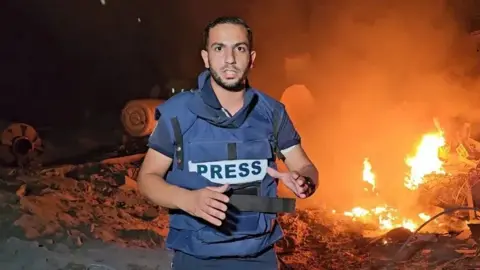On August 11, 2025, an Israeli military strike near Al-Shifa Hospital in Gaza City resulted in the tragic deaths of five Al Jazeera journalists. This incident has triggered widespread condemnation and raised serious concerns regarding press freedom in conflict zones. Among those killed were correspondents Anas al-Sharif and Mohammed Qreiqeh, alongside cameramen Ibrahim Zaher, Mohammed Noufal, and Moamen Aliwa, who were inside a tent for journalists near the hospital’s main entrance when the strike occurred.
Al Jazeera swiftly condemned the attack, characterizing it as a “targeted assassination” designed to undermine journalistic freedom. In a statement, the network indicated that this incident marked another blatant violation against the rights of journalists to report in war zones. The attack not only affected the lives of these journalists but also curtailed the vital flow of information from the Gaza Strip, a region where accurate reporting has become increasingly challenging.
Immediately following the strike, the Israel Defense Forces (IDF) acknowledged that they initiated the military action. In a message posted on Telegram, the IDF alleged that al-Sharif had served as the head of a terrorist cell affiliated with Hamas, justifying their attack. However, no acknowledgement was made regarding the other four journalists who lost their lives in the strike.
According to Al Jazeera, the total number of fatalities in the attack amounted to seven individuals. Initially, the network reported that four of its staff members had been killed, but this number was later updated to five. Mohamed Moawad, Al Jazeera’s managing editor, underscored that al-Sharif was an accredited journalist whose work was crucial for providing accurate information from the ground in Gaza. He highlighted that throughout the ongoing conflict, Israel has restricted international journalists’ access to the region, leaving local reporters as the primary sources for news coverage.
Moawad further emphasized the targeted nature of the attack, noting that the journalists were not reporting from the frontline but were in a designated press area. He articulated the perspective that such acts signify an intent by the Israeli government to silence independent reporting from Gaza, noting the unprecedented scope of these actions in modern history.
In the lead-up to the tragic event, al-Sharif, aged 28, reportedly shared updates on social media about the escalating bombardments in Gaza City. It was revealed that a post issued anonymously after his reported death likely originated from a friend, illustrating the harrowing circumstances surrounding the journalists’ final moments. Graphic footage following the strike, validated by BBC Verify, captured the aftermath, showing men hurriedly carrying bodies, with individuals calling out al-Sharif’s name amidst the chaos.
The IDF’s statement went on to assert that al-Sharif had been masquerading as a journalist, alleging that he was involved in directing rocket attacks against both Israeli civilians and military personnel. Additionally, they claimed to have possessed prior intelligence affirming his military associations and involvement in terrorist training. The IDF maintained that precautions were taken to minimize civilian harm during the strike, implying a level of justification for their actions.
This incident is not an isolated one, as it comes amid broader concerns for journalists’ safety in conflict areas, notably highlighted by the alarming statistics from the Committee to Protect Journalists (CPJ). Since the recent escalation of military operations in Gaza, 186 journalists have been reported killed, a stark reminder of the dangers faced by media personnel in the line of duty.
The global community, including organizations such as the United Nations, has begun to scrutinize the ongoing violence against journalists in Gaza, with calls for enhanced protections and acknowledgment of their critical role in informing the public during armed conflicts. Al Jazeera’s statement encapsulated the sentiment of outrage and concern, depicting the IDF’s actions as part of a perilous campaign against its correspondents in the region, echoing the fears surrounding freedom of the press in areas afflicted by war.











